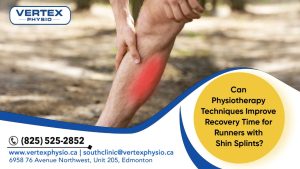
Shin splints, a common injury among runners, can significantly impede performance and comfort. Sports physiotherapy in Edmonton offers a range of specialized shin splint therapies designed to accelerate recovery and prevent future injuries. By focusing on treatment and education, sports physiotherapists in Edmonton help runners recover from existing injuries and enhance their running form to reduce the risk of recurrence. This integrated approach ensures that runners can return to their activities faster and more effectively.
Manual Therapy
Techniques
Soft Tissue Mobilization:
- Application: Techniques such as deep tissue massage, myofascial release, and trigger point therapy are employed, focusing on the muscles of the lower leg, including the gastrocnemius, soleus, and tibialis anterior. The physiotherapist uses hands-on manipulation to gently massage and stretch the muscle fibres, helping to break down adhesions and loosen tight tissues.
- Procedure:The physiotherapist applies pressure to the affected muscles with their hands or tools to enhance blood circulation and lymphatic drainage, promoting healing in the tissue structures around the shin.
Joint Mobilization:
- Application:This involves passive movements and manipulations of the ankle and foot joints. The physiotherapist performs gentle gliding techniques on the joint surfaces, mobilizes the bones and stretches the joint to improve the range of motion.
- Procedure:Techniques such as distraction (pulling the joint surfaces apart), gliding (sliding the joint surfaces), and rotating (turning the joint) are typically utilized to improve functionality and decrease stiffness.
Benefits
- Pain Reduction: Manual therapy helps ease muscle tightness and reduce localized inflammation around the shin area, providing significant pain relief.
- Improved Mobility:Manual therapy supports healing by enhancing joint function and flexibility in the lower leg and can prevent the compensation patterns that lead to additional stress on the shin.
Exercise Therapy
Techniques
Strengthening Exercises:
- Toe Curls: The athlete curls their toes to grasp a towel laid on the floor, pulling it toward themselves to strengthen the muscles of the foot and lower leg.
- Calf Raises: Standing on a flat ground, lift the heels off the ground, balance on the toes, and then slowly lower back down.
- Resisted Ankle Dorsiflexion: Using a resistance band around the foot, the athlete pulls their toes toward their shin against the band’s resistance.
Flexibility Exercises:
- Standing Calf Stretches: The athlete stands facing a wall with one foot in front of the other, the front knee slightly bent, and the back leg straight, then leans into the wall until a stretch is felt in the calf of the back leg.
- Seated Towel Stretches:Sitting with legs extended, the athlete loops a towel around the ball of their foot and gently pulls the towel towards themselves, keeping the knee straight to stretch the calf and the arch of the foot.
Benefits
- Reduced Load on the Shin:Strengthening the lower leg and foot muscles helps evenly distribute the forces exerted during running and other activities, which can lessen the stress on the shin bones.
- Increased Tissue Elasticity:Regular flexibility exercises enhance the elasticity of the calf muscles and connective tissues, reducing the tension exerted on the shin and minimizing the risk of reoccurring shin splints.
Gait Analysis
Technique
Comprehensive Evaluation:
- Tools Used: Technology such as video analysis software or 3D motion capture systems are often employed, along with force plates, to measure the impact on various parts of the foot during the running cycle.
- Procedure: The runner is typically observed running on a treadmill or overground in a controlled environment. The physiotherapist records and analyzes the runner’s movements to identify any deviations from an ideal gait pattern that could lead to increased stress on the shins, such as overpronation or inadequate hip stabilization.
Corrective Feedback:
- Real-Time Feedback:Utilizing the data collected during the evaluation, the physiotherapist provides immediate feedback to the runner. This might involve showing the runner video clips highlighting specific biomechanical issues.
- Strategy Implementation:Based on the analysis, specific corrections are suggested, such as adjusting stride length, altering foot strike patterns, or modifying running posture.
Benefits
- Injury Prevention: By correcting biomechanical inefficiencies, the adjustments help distribute the forces more evenly across the lower legs, reducing the load on the shins and thereby minimizing the risk of shin splints.
- Performance Enhancement:Improved running mechanics can also lead to better performance, as energy efficiency is enhanced and less strain is put on the body.
Shockwave Therapy
Technique
High-Energy Sound Waves:
- A device that generates shockwaves emits these waves through a conducting gel applied to the skin over the shin area.
- The treatment sessions usually last between around 10 minutes, depending on the severity of the condition and the specific device used. Multiple sessions, generally spaced a week apart, are often required for maximum effectiveness.
Benefits
Accelerated Tissue Repair:
- Enhanced Cellular Activity: The shockwaves induce microtrauma in the tissue, which induces the body’s natural healing processes, also including the release of growth factors and the recruitment of repair cells.
- Increased Blood Flow: The treatment promotes neovascularization, or new blood vessel formation, enhancing blood circulation to the area, which speeds up the healing process.
Pain Management:
- Immediate Relief:Many patients report a significant reduction in pain immediately following the therapy sessions. This is attributed to the shockwaves’ ability to reduce inflammation and possibly desensitize pain receptors in the affected area.
- Long-Term Benefits:As the underlying tissue injuries heal, the pain associated with shin splints diminishes, enabling a quicker return to activity.
Sports Physiotherapy in Edmonton ensures that runners can return to their sport stronger and more resilient.
Swift Steps to Recovery
Vertex Physiotherapy offers specialized sports injury physiotherapy that significantly improves recovery times for runners with shin splints. For runners struggling with this common yet frustrating injury, Vertex Physiotherapy provides comprehensive care. If shin splints are slowing you down, consider seeking the help of the experienced professionals at Vertex Physiotherapy. Our commitment to sports physiotherapy in Edmonton can help you return to your running routine with confidence and improved performance.

